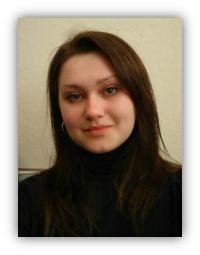Interview with Daria Astapovych
 Daria Astapovych was born in Sumy, Ukraine in May 1990 and gained her diploma in physics at the Sumy State Pedagogical University. She obtained a bachelor’s degree in physics during which she undertook pedagogical practice in schools as a teacher of physics and mathematics within the course ‘General Physics and Electromagnetism’. In May 2012 Daria obtained a master’s degree in physics. She decided to focus on a computer simulation for beam dynamics, specifically in the electron cooling process using BETACOOL and worked at the Institute of Applied Physics of the National Academy of Science of Ukraine.
Daria Astapovych was born in Sumy, Ukraine in May 1990 and gained her diploma in physics at the Sumy State Pedagogical University. She obtained a bachelor’s degree in physics during which she undertook pedagogical practice in schools as a teacher of physics and mathematics within the course ‘General Physics and Electromagnetism’. In May 2012 Daria obtained a master’s degree in physics. She decided to focus on a computer simulation for beam dynamics, specifically in the electron cooling process using BETACOOL and worked at the Institute of Applied Physics of the National Academy of Science of Ukraine.
Daria joined the oPAC project as Marie Curie Fellow in 2013. Her research was focused on studying the single-bunch instabilities observed in the LHC, the verification of the accuracy of the impedance model, using HEADTAIL and NHTVS.
What did attract you to the oPAC network? Has it fulfilled your expectations?
In 2012 I graduated from the University with Master degree and started to think about my future. I was and still interested in physics, especially in accelerator physics. I tried my luck searching the position in couple of famous organisations. And once I came across the oPAC project. Searching more information about the oPAC network I was surprised that it was so easy to apply, the application is open for everyone.
I can confidently say, that it was the best decision in my life to start working under the oPAC. As for me, the oPAC means meeting new people, mobility, improving knowledge through attending different conferences, schools. I would never regret about the network. It gave as much as possible and helped me with the decision for my future.
Why did you choose to go to CERN?
In the University I was very interested in nuclear physics and tried to read more and more to understand how people do this — how do they understand the nature. I found a lot about the LHC and couldn’t imagine that it’s possible to build such a giant machine. I dreamed about the possibility to work there. And sometimes dreams come true.
Can you explain in a few words what your project was about and what have you achieved?
My project was related to the study of the single bunch instabilities in the LHC. Transverse collective instabilities are one of the most important limitations to achieve the highest luminosities in the LHC and have been regularly observed during the LHC Run I.
The goal of this study is to verify the accuracy of the impedance model to be able to make predictions for the future operation of LHC. It was done with the tracking HEADTAIL code using the LHC impedance model.
The result of this work was a published report at CERN External Notes under the supervision of Elias Metral and Nicolas Mounet.
What has oPAC provided you professionally?
I think the project gave me quite a lot. It helped me to strengthen my knowledge in physics, in particular, beam dynamics; improved my skills as a scientist; high quality trainings contributed a lot into my personal skills.
I would like to be objective in this question, but the oPAC gave me quite a lot: starting with improving my knowledge in physics, in particular, beam dynamics, and finishing with development of my personal qualities.
What are your professional plans now that oPAC has finished?
Three years is a quite long period and it was a time for me to think where I see myself in the future. I could definitely say that I still would like to stay in the science and, probably, to become a professor in the later future
What will be your most cherished memory from oPAC?
It’s really difficult to highlight just one think. But I would never forget two events. The first one is the ESOF 2014. Carsten Welsch proposed to go to Copenhagen and give a small talk about the oPAC. I was so overjoyed to meet on this forum the Nobel prize winner Prof. Dr. Serge Haroche and had a chance to talk with him. The second, but not least, is the Symposium on Lasers and Accelerators for Science & Society in Liverpool. It was so amazing to meet one of the great populariser of science Prof. Brian Cox.